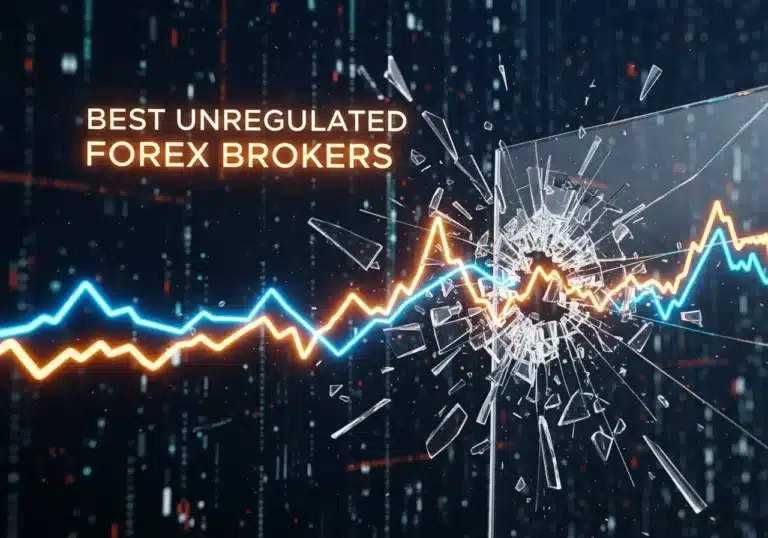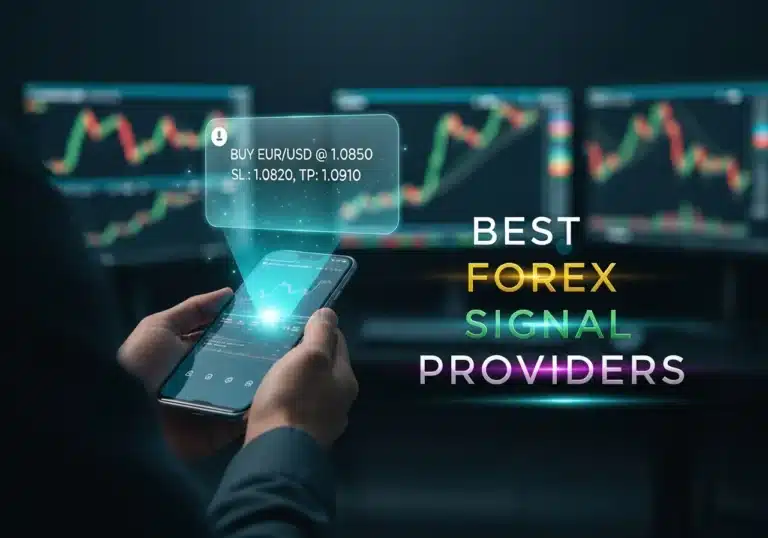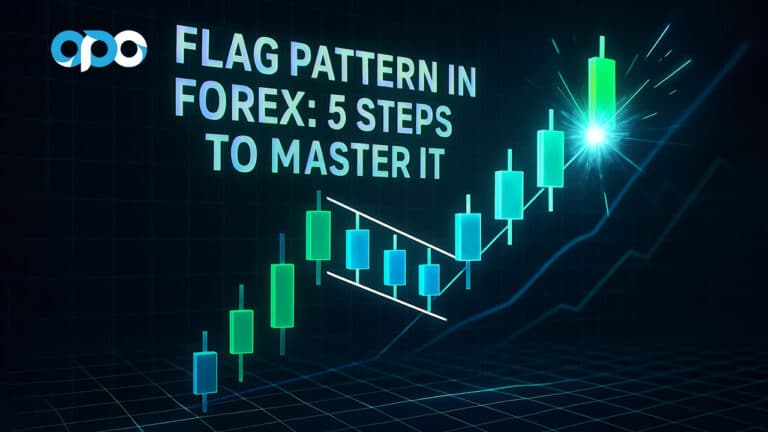Have you ever felt that sharp sting after a trade goes wrong? That urgent, almost desperate need to jump straight back into the market and claw back your losses? That intense emotional reaction is exactly what is revenge trading. It’s when feelings like anger or frustration take over your trading decisions, causing you to act impulsively instead of logically. This often leads to more losses and is a common issue for traders using any broker for forex trading. This article will explain this harmful pattern and give you clear, practical advice on how to stop revenge trading.
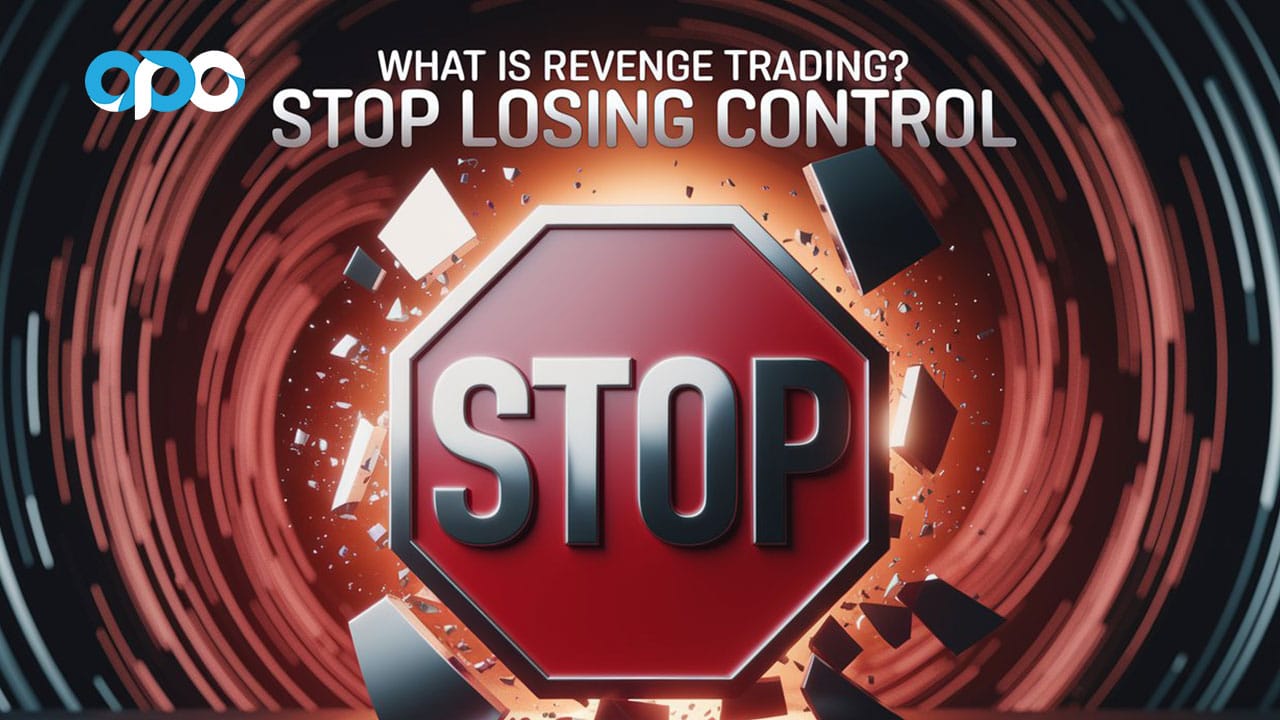
Recognizing the Signs: Are You Revenge Trading?
Noticing the signs of revenge trading in yourself is the essential first step. It can feel like strong determination, but it’s usually just negative emotions driving your actions. Being honest with yourself is vital. Do these behaviors seem familiar, especially right after a losing trade?
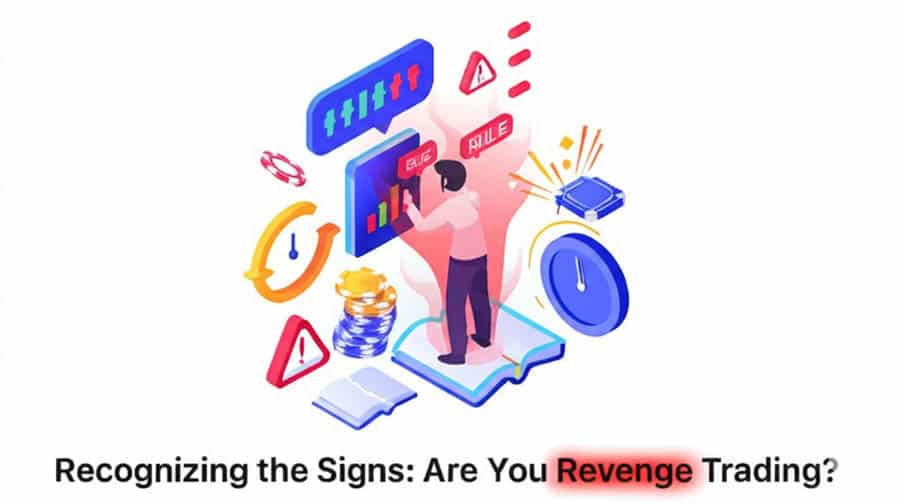
The Immediate Need to ‘Get Even’
This is the most obvious signal. You close a trade at a loss, and instead of pausing to think, you feel a powerful urge to place another trade immediately. Your goal isn’t based on your strategy; it’s purely about wiping out the previous loss. Anger, frustration, or panic often fuels this reaction. Understanding what is revenge trading involves seeing this immediate, emotional response clearly.
Tossing Your Trading Plan Aside
A trading plan acts as your guide, outlining your rules for entry, exit, risk, and setups. When revenge trading takes hold, this guide is often ignored. You might take trades that don’t meet your criteria, skip your usual analysis steps, or enter the market simply because you feel it must go your way. Ignoring your own rules is a major warning sign of revenge trading.
Suddenly Betting Big
Trying to recover losses fast often leads traders to significantly increase their position size. The flawed thinking is, “A bigger bet means I can make back the loss with just a small win.” This ignores proper risk management. A single oversized loss driven by emotion can cause much more damage than the original loss you were trying to recover. This is a frequent mistake when experiencing what is revenge trading.
Read More: How to Overcome Greed in Forex Trading
Fixating on a Losing Asset or Getting Reckless
You might become obsessed with the specific asset that caused your loss, trying to force a win from it even if the valid setup is gone. Alternatively, you might swing wildly and jump into much riskier trades or assets you wouldn’t normally touch, hoping for a quick, large gain. This ‘chasing’ behavior is a clear indicator of emotional trading, not strategic thinking.
Feeling Glued to the Screen
Do you find it impossible to step away after a loss? Are you constantly watching every price movement, searching for any excuse to re-enter the market? This inability to take a break suggests emotions are high and affecting your judgment. Smart trading includes knowing when to step back. Realizing this is part of learning how to stop revenge trading.
Trading on Impulse, Not Insight
Revenge trading often involves quick, impulsive decisions. You might see a small price move in your favor and jump in without properly checking support/resistance, indicators, or the overall market trend. The motivation isn’t analysis; it’s the desperate need to act and recover the loss. If your main reason for entering a trade is “I need to get that money back,” you’re likely in the grip of revenge trading.
Why Does This Happen? The Underlying Causes
So, why do traders fall into this pattern? Knowing the root causes of revenge trading can make it easier to combat. It’s usually about more than just the lost money; deeper psychological factors are often involved.
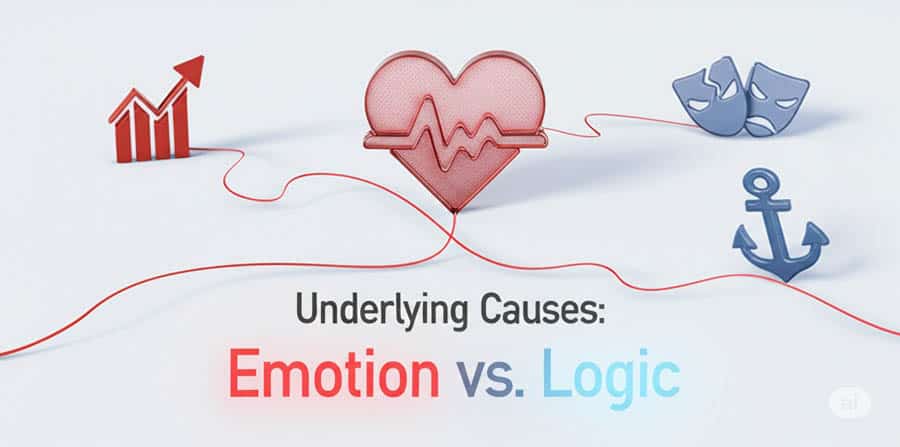
Common triggers include a large, unexpected loss, a series of smaller frustrating losses, or even a profitable streak ending suddenly. Ego can also play a part; feeling ‘beaten’ by the market can make a trader want to prove it wrong. Psychologically, factors like loss aversion (where the pain of a loss feels stronger than the pleasure of an equal gain) increase the desperation to undo the loss. Anger and frustration cloud clear thinking. Fear—fear of more losses or fear of missing out on a potential recovery—can also lead to poor decisions. Understanding these triggers is essential if you want to know how to stop revenge trading.
Read More: Trading Psychology in Forex: Mastering Emotions for Success
The Steep Price of Revenge Trading
Giving in to revenge trading has consequences far beyond a single bad trade. It creates a negative cycle that can seriously harm your trading capital, your mental health, and your overall trading future. The impact of what is revenge trading can be severe.
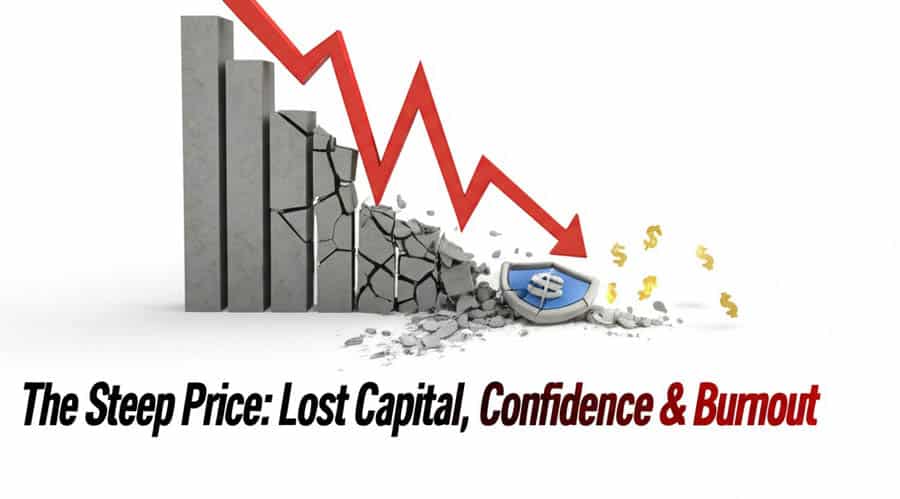
Watching Your Capital Vanish
This is the most direct and painful result. Making decisions based on emotion, often with oversized positions and ignoring risk rules, can lead to large losses very quickly. One session dominated by what is revenge trading can wipe out weeks or even months of careful trading profits.
Read More: How to Deal with Trading Losses
Losses Snowballing
One bad decision driven by emotion rarely happens alone. It often leads to another as you try to ‘fix’ the first mistake by making another impulsive trade. Chasing losses, abandoning your strategy, and increasing risk create a downward spiral. Each subsequent trade made under emotional pressure is less likely to succeed, digging a deeper financial hole.
Emotional Drain and Burnout
Constantly fighting the market emotionally is exhausting. The cycle of loss, anger, impulsive trading, and more loss takes a heavy toll on mental well-being. This can lead to high stress, anxiety, sleep problems, and eventually, complete burnout, making it difficult to trade effectively.
Shattered Trading Confidence
Repeatedly engaging in revenge trading damages your self-trust. You start to doubt your ability to follow your plan, manage risk, and make rational decisions under pressure. This lack of confidence can be paralyzing, causing you to hesitate on good setups or exit winning trades too soon. Understanding what is revenge trading helps you see how it undermines your progress.
How to Stop Revenge Trading in Its Tracks
Alright, you recognize the signs. The anger is rising, and the urge to click that button is strong. What should you do right now? Acting quickly is crucial to prevent further damage. Here’s an emergency plan for how to stop revenge trading immediately.
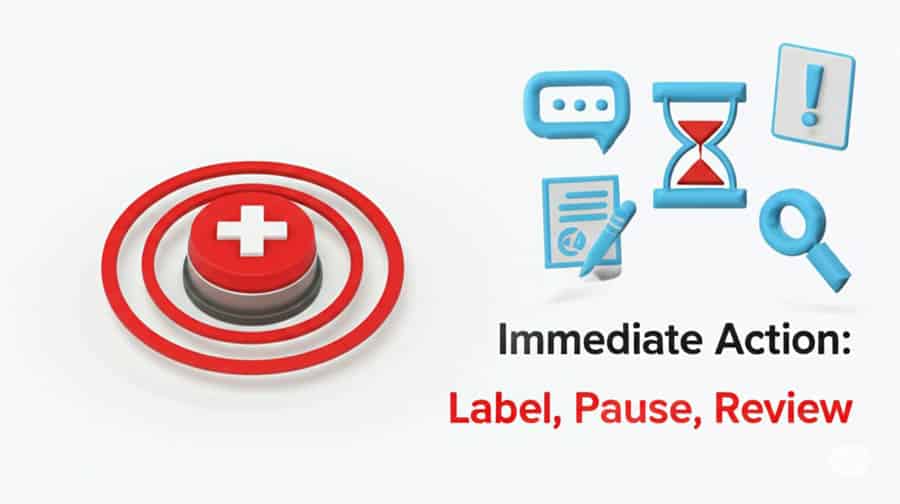
Step 1: Full Stop. Now.
The moment you feel that emotional heat, that intense urge to counter-attack the market – stop everything. Don’t place another trade. Don’t even stare at the chart. Close your trading platform. Get up from your desk and physically walk away. Creating physical distance helps create mental distance.
Step 2: Label the Emotion
Acknowledge the feeling without judging yourself. Say it out loud or write it down: “I am feeling angry,” or “I feel frustrated and want to chase that loss.” Simply naming the emotion can reduce its control over you. It helps you observe the feeling instead of being consumed by it.
Step 3: Take a Mandatory Time-Out
You must take a break. It’s not optional. The length depends on how intense the emotion is, but aim for at least 15-30 minutes, or perhaps even stop trading for the day. The key is to do something completely unrelated to trading. Go for a walk, listen to music, call a friend (about anything but trading), play with a pet – anything to change your mental state.
Step 4: Perform a Post-Mortem (Later!)
Once you are completely calm – which might be hours later or the next day – review the trade that triggered the emotional response. Look at it objectively. Did the setup meet your plan’s criteria? Did you follow your entry, stop-loss, and exit rules? Was the loss simply bad luck (which happens!), or did you make a mistake? Focus on the process, not on blaming the market or yourself. This analysis is part of learning how to stop revenge trading effectively.
Building Your Long-Term Defenses
While stopping revenge trading in the moment is important, the long-term goal is to prevent it from happening frequently. This requires building strong habits and systems around your trading approach. Preventing the urge is the best way how to stop revenge trading.
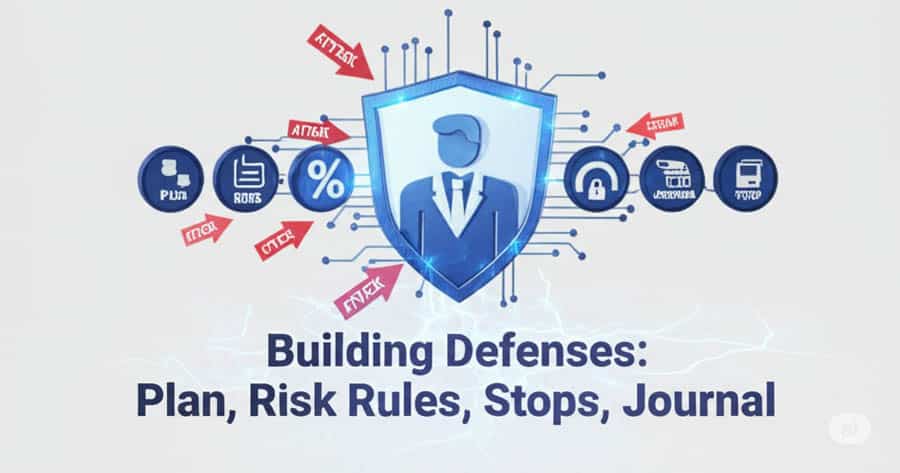
Strategy 1: Have a Plan and Actually Use It
Your trading plan is your main shield against emotional decisions. It must clearly define: Market conditions you trade in. Specific entry setups. Exact entry and exit rules (including stop-losses!). How much capital you risk per trade (e.g., 1%). Your maximum loss limits (daily/weekly). Having the plan isn’t enough; you must follow it strictly. Keep it visible, review it daily, and be accountable. Understanding what is revenge trading emphasizes why sticking to your plan is vital.
Strategy 2: Hard Rules on Risk
Set firm limits on potential losses. Define your maximum risk for any single trade (e.g., 1-2%). More importantly, establish a maximum daily loss limit (e.g., 3-5% of capital) and possibly a weekly limit. If you hit that limit, you must stop trading for that period. No excuses. Some brokers let you set these limits automatically. If not, you need the discipline to enforce them yourself. This prevents one bad day fueled by revenge trading from causing major damage.
Strategy 3: Stop-Losses are Non-Negotiable
Every trade needs a pre-defined stop-loss order placed at the time of entry. This sets your maximum acceptable loss for that trade idea before emotions get involved. It takes the difficult decision of cutting losses out of the heat of the moment. Deciding your exit point beforehand, when you are calm, prevents you from holding onto losers hoping they’ll turn around – a common path towards revenge trading.
Strategy 4: Journal Your Trades and Feelings
Your trading journal should track more than just entry/exit points and profits/losses. Critically, record your emotional state and thinking before, during, and after each trade. How did you feel? Were you calm, anxious, rushed? Why did you take the trade? Did it fit your plan? How did you feel after closing it? Reviewing this helps you spot patterns where certain emotions (like frustration after a loss) lead to poor decisions. Identifying your triggers is key to understanding your personal experience with what is revenge trading.
Strategy 5: Keep Expectations Grounded
Accept that losing trades are a normal part of trading. No strategy wins 100% of the time. Even top traders have losing days or weeks. Expecting never to lose sets you up for frustration, making you more vulnerable to revenge trading when losses inevitably occur. Focus on consistently applying your strategy and managing risk well over the long term, not on getting rich quickly.
Getting Back Up After a Stumble
Let’s be realistic: even with good defenses, you might slip up sometimes and engage in revenge trading. The crucial part is how you handle it afterward. Don’t beat yourself up, but don’t ignore it either. Use it as a chance to learn and reinforce your discipline.
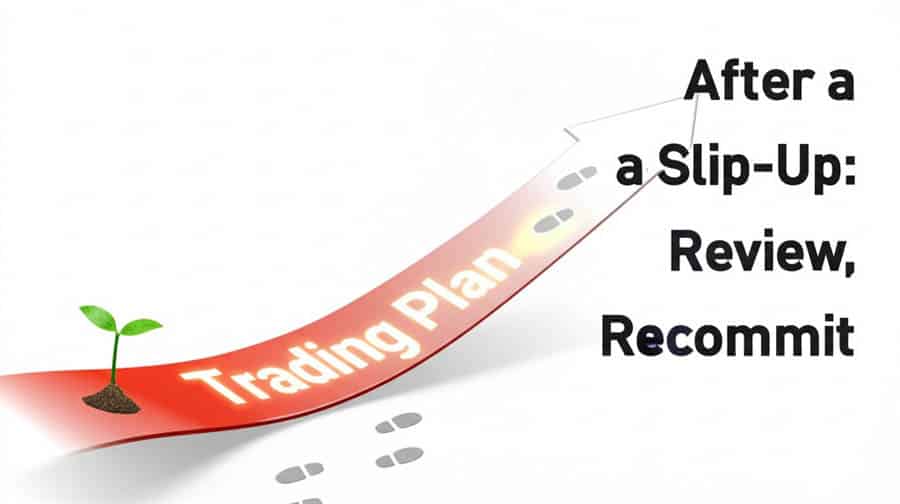
First, honestly review what happened. Check your journal or write detailed notes. When exactly did you deviate from your plan? What was the trigger – a specific loss amount, a market event, external stress? What rules did you break (e.g., oversized position, ignored stop-loss)? Be specific without making excuses. When you feel ready to trade again, consider significantly reducing your position size for a while.
This lowers the emotional stakes and helps you focus purely on executing your plan correctly. Finally, consciously reaffirm your commitment to your trading plan and risk rules. Remind yourself why they exist – to protect you from the exact situation you just experienced. This reflection is a practical step in how to stop revenge trading from repeating.
Building Lasting Trading Discipline
Truly overcoming the tendency for revenge trading involves developing a deeper, more resilient trading mindset. This isn’t a quick fix; it’s an ongoing process focused on consistency, self-awareness, and emotional management. This long-term view is central to how to stop revenge trading permanently.
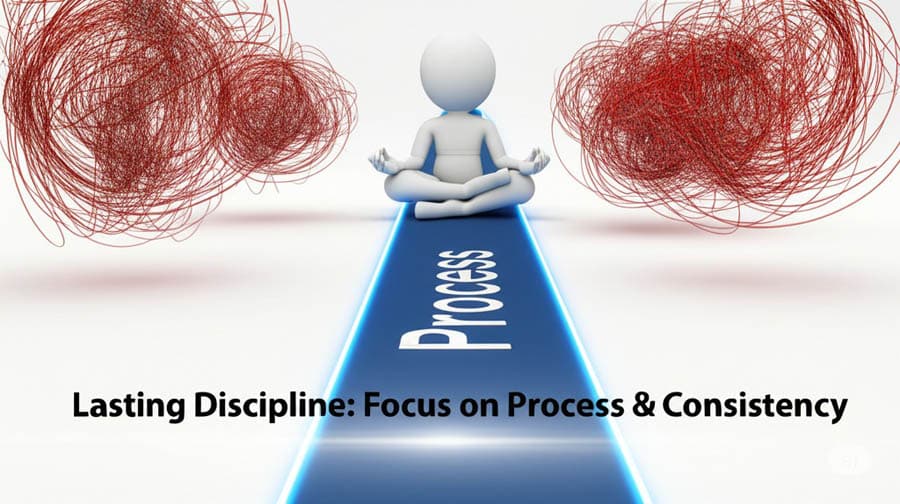
Focus on consistency rather than intensity. Sustainable trading success comes from methodically applying your edge over many trades, not from occasional high-risk actions. Prioritize flawless execution of your plan day after day. Regularly review your performance (e.g., weekly), but focus on your process, not just the profit or loss. Did you follow your rules? Manage risk effectively? Maintain emotional control?
Improving your process generally leads to better results over time. Work on emotional resilience through techniques like mindfulness or ensuring a healthy work-life balance. Critically, learn to recognize when you are not in the right mental state to trade. If you are highly stressed, angry, or distracted, have the discipline to stay out of the market. Knowing when not to trade is as important as knowing when to trade, especially concerning what is revenge trading.
Opofinance: Trade Smarter, Not Angrier
Navigating the markets successfully requires not only discipline but also the right tools and support. Opofinance, an ASIC-regulated broker, offers a robust environment designed to empower traders and help them maintain objectivity.
- Advanced Trading Platforms: Choose from industry-leading platforms like MT4, MT5, cTrader, and the intuitive OpoTrade platform to suit your trading style.
- Innovative AI Tools: Leverage cutting-edge technology with an AI Market Analyzer for insights, an AI Coach to refine your strategy, and AI Support for assistance. These tools can help maintain objectivity, counteracting the emotional basis of what is revenge trading.
- Social & Prop Trading: Explore opportunities in social trading to learn from others or participate in proprietary trading programs.
- Secure & Flexible Transactions: Benefit from safe and convenient deposit and withdrawal methods, including popular cryptocurrencies, with the added advantage of zero transaction fees charged by Opofinance.
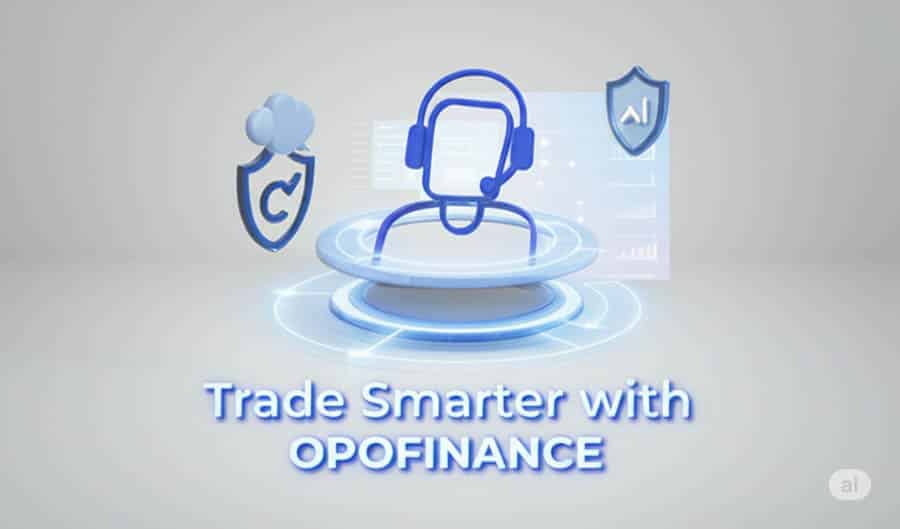
Take control of your trading journey with a supportive and technologically advanced broker. Understanding the risks, like those associated with revenge trading, is easier to manage with good resources.
Conclusion: Choose Strategy Over Spite
So, what is revenge trading? In short, it’s letting losses dictate your actions through anger and impulse, essentially waging a personal battle against the market – a battle you’re likely to lose. It drains accounts and spirits. But it is preventable. Recognizing the signs, stopping immediately, rigidly following your plan, managing risk carefully, and journaling your emotions are your key tools. Building discipline takes effort, but it’s fundamental for long-term success. Choose logic over emotion, and learn how to stop revenge trading before it costs you dearly.
Key Takeaways
- What is Revenge Trading: Trading based on emotion (anger, frustration) after losses, marked by impulsivity and high risk, aiming for quick recovery instead of following a strategy.
- Spot the Signs: Immediate urge to trade after loss, ignoring the plan, sudden large position sizes, chasing losses, inability to step away, impulsive entries.
- Immediate Response: Stop all trading instantly, identify the emotion, take a mandatory break completely away from trading, analyze the loss objectively only when calm.
- Build Your Defenses: Essential prevention includes a strict trading plan, firm risk/loss limits, consistent stop-loss use, journaling emotions and decisions, and realistic expectations. These are core to how to stop revenge trading.
- Discipline is Paramount: Consistent execution of a sound strategy and disciplined risk management are far more effective long-term than reacting emotionally to market movements. Avoiding what is revenge trading requires this discipline.
Can revenge trading happen in any market, like stocks or crypto, not just forex?
Absolutely. Revenge trading is a psychological reaction linked to human emotion and loss, not tied to any specific market. Whether you’re trading forex, stocks, crypto, commodities, or futures, the same feelings (frustration, anger after a loss) can trigger the same harmful behaviors like ignoring plans, increasing bets, and chasing losses. The core problem of what is revenge trading is universal.
Is taking a break absolutely necessary after every single loss?
Not always after every minor loss, particularly if it was expected within your strategy and doesn’t stir strong emotions. However, a break is highly recommended after significant losses, unexpected results, or a series of small losses that start causing frustration. Self-awareness is key. If you feel any emotional reaction – irritation, anger, the urge to immediately ‘fix’ it – stepping away is the best course of action. This pause helps reset your mindset and is a simple technique for how to stop revenge trading from escalating.
How exactly does a trading journal help prevent revenge trading, beyond just tracking trades?
A trading journal’s effectiveness against revenge trading comes from tracking your emotional state and decision rationale alongside trade specifics. By regularly noting how you felt before entering (Calm? Anxious? Rushed?), why you took the trade (Did it meet plan rules?), and your feelings after closing (Relieved? Frustrated?), you gather valuable self-data. Reviewing this helps you see patterns. For instance, you might find that after two losses, you often feel frustrated and tend to break risk rules on the next trade. Identifying this specific trigger helps you anticipate it and apply countermeasures (like a mandatory break after two losses) before revenge trading starts. It clarifies the link between your feelings and trading errors, which is crucial for addressing what is revenge trading.




